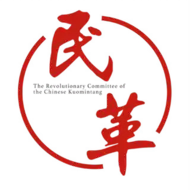Revolutionary Committee of the Chinese Kuomintang
The Revolutionary Committee of the Chinese Kuomintang (Chinese: 中国国民党革命委员会; pinyin: Zhōngguó Guómíndǎng Gémìng Wěiyuánhuì) is one of the eight legally recognised minor political parties in the People's Republic of China that follow the direction of the Communist Party of China. It was founded in January 1948, during the height of the Chinese Civil War, by members of the left wing of the Kuomintang (KMT), especially those who were against Chiang Kai-shek's policies. The first Chairman of the party was General Li Jishen, a senior Nationalist military commander who had many disputes with Chiang over the years, while Song Qingling (the widow of Sun Yat-sen) was named Honorary Chairwoman. Other early leading members were Wang Kunlun, Cheng Qian, He Xiangning and Tao Zhiyue. The party claims to be the true heir of Sun Yat-sen's legacy. By the end of 2017, it had 131,410 members.[2]
Revolutionary Committee of the Chinese Kuomintang | |
|---|---|
 | |
| Abbreviation | RCCK |
| Chairperson | Wan Exiang |
| Founded | 1 January 1948 |
| Split from | Kuomintang |
| Preceded by | Left wing of the Kuomintang |
| Headquarters | Donghuachenggen South Street Donghuamen Subdistrict, Beijing |
| Newspaper | Tuanjie Bao (Solidarity/Unity Daily)[1] Tuanjie (Unity) |
| Membership (2017) | 131,410[2] |
| Ideology | Three Principles of the People Socialism with Chinese characteristics Chinese unification Chinese nationalism Xi Jinping Thought[3][4] |
| National affiliation | United Front |
| National People's Congress | 43 / 2,980 |
| NPC Standing Committee | 6 / 175 |
| Website | |
| Official website | |
| Revolutionary Committee of the Chinese Kuomintang | |||||||||||||
|---|---|---|---|---|---|---|---|---|---|---|---|---|---|
| Chinese name | |||||||||||||
| Simplified Chinese | 中国国民党革命委员会 | ||||||||||||
| Traditional Chinese | 中國國民黨革命委員會 | ||||||||||||
| Literal meaning | "Revolutionary Committee of the Nationalist Party of China" | ||||||||||||
| |||||||||||||
| Abbreviation | |||||||||||||
| Chinese | 民革 | ||||||||||||
| |||||||||||||
| Tibetan name | |||||||||||||
| Tibetan | ཀྲུང་གོ་གོ་མིན་ཏང་གསར་བརྗེ་ཨུ་ཡོན་ལྷན་ཁང | ||||||||||||
| |||||||||||||
| Zhuang name | |||||||||||||
| Zhuang | Cunghgoz Gozminzdangj Gwzming Veijyenzvei | ||||||||||||
| Mongolian name | |||||||||||||
| Mongolian Cyrillic | Дундад улсын гоминдангийн хувьсгалын зөвлөл | ||||||||||||
| Mongolian script | ᠳᠤᠮᠳᠠᠳᠤ ᠤᠯᠤᠰ ᠤᠨ ᠭᠣᠮᠢᠨᠳᠠᠩ ᠤᠨ ᠬᠤᠪᠢᠰᠬᠠᠯ ᠤᠨ ᠵᠥᠪᠯᠡᠯ | ||||||||||||
| Uyghur name | |||||||||||||
| Uyghur | جۇڭگو گومىنداڭ ئىنقىلابىي كومىتېتى | ||||||||||||
| |||||||||||||
| Manchu name | |||||||||||||
| Manchu script | ᠮᡳᠨᡬᡝ | ||||||||||||
| Romanization | Ming'e | ||||||||||||
Song Qingling served as Vice President of the People's Republic of China and Honorary President of the People's Republic of China. Li Jishen served as Vice Chairman of the Central People's Government and Vice Chairman of the Central Military Commission.
Among the officially sanctioned political parties of the People's Republic of China, the Revolutionary Committee is seen as second in status to the Communist Party of China. Thus, the Revolutionary Committee is allotted the second highest number of seats in the People's Political Consultative Conference (30%). It also owns numerous assets, some formerly owned by the Kuomintang, throughout mainland China. The Revolutionary Committee operates a range of party-owned institutions, such as party schools.
History
After the end of World War II, the relationship between the Chinese Kuomintang and the Chinese Communist Party, who had allied to fight the Japanese, became increasingly tense; ultimately, both sides re-started the civil war, which World War II had interrupted.
In 1945 and 1946, members of the Kuomintang's left wing formed the Three People's Confederation of Comrades and the China Nationalist Democratic Promotion Association in Chongqing and Guangzhou, respectively.
In November 1947, the first joint representative meeting of the Kuomintang left was held in Hong Kong; on January 1, 1948, the meeting announced the official establishment of the "Chinese Kuomintang Revolutionary Committee", and nominated Soong Ching-ling, the widow of Sun Yat-sen, as the Honorary Chairman of the Revolutionary Committee (despite Soong Ching-ling never formally joining the commission).[5]
Chairman Li Jishen, He Xiangning, and Feng Yuxiang were selected as the central leadership of the organization.[6]
In 1949, Li Jishen and other representatives of the RCCK were invited by the Communist Party of China to participate in Chinese People's Political Consultative Conference.[5]
After the founding of the People's Republic of China in October 1949, members of the Chinese Kuomintang Revolutionary Committee maintained positions in the municipal and central governments.[6]
In November 1949, the second congress of the Chinese Kuomintang Revolutionary Committee was held in Beijing. At the second congress, the Chinese Kuomintang Revolutionary Committee, Chinese Nationalist Democratic Promotion Association, the Comrades of the Three Peoples Principles, and other members of the Kuomintang's left wing agreed to merge and form the Revolutionary Committee of the Chinese Kuomintang.[6]
Today, the Revolutionary Committee of the Chinese Kuomintang focuses on improving relations with the Kuomintang on Taiwan, and its membership mainly consists of the descendents of Kuomintang revolutionaries.[6][7]
Central Committee
.jpg.webp)
The Central Committee of the Revolutionary Committee of the Chinese Kuomintang has six working departments including the General Office, the Organization Department, the Propaganda Department, the Liaison Department, the Social Services Department, and the Research Department.[8]
Chairpersons of the Central Committee
- Li Jishen (李济深) (1948–1959)
- He Xiangning (何香凝) (1960–1972)
- Zhu Yunshan (朱蕴山) (1979–1981)
- Wang Kunlun (王昆仑) (1981–1985)
- Qu Wu (屈武) (1987–1988)
- Zhu Xuefan (朱学范) (1988–1992)
- Li Peiyao (李沛瑶) (1992–1996)
- He Luli (何鲁丽) (1996–2007)
- Zhou Tienong (周铁农) (2007–2012)
- Wan Exiang (万鄂湘) (2012–present)[9]
Honorary Chairpersons of the Central Committee
- Song Qingling (宋庆龄) (1948–1949)
- Qu Wu (屈武) (1988–1992)
- Zhu Xuefan (朱学范) (1992–1996)
- Hou Jingru (侯镜如) (1992–1994)
- Sun Yueqi (孙越崎) (1992–1995)
Chairpersons of provincial committees
- Han Youwen – Chairman of the Xinjiang Branch[10][11]
Electoral history
National People's Congress elections
| Election year | Number of seats |
|---|---|
| 2017–18 | 43 / 2,970 |
See also
References
- "Unity Daily" 团结报数字报 (in Chinese). Archived from the original on 2018-01-11. Retrieved 2018-01-11.
- "Introduction to the Revolutionary Committee of the Chinese Kuomintang" 中国国民党革命委员会简介. Minge.gov.cn (in Chinese). 2018-04-09. Archived from the original on 2019-05-26. Retrieved 2019-03-08.
- 民革第十三次全国代表大会暨民革成立70周年纪念大会在京开幕 王沪宁代表中共中央致贺词-人民资讯-人民网. Minge.gov.cn (in Chinese). 2017-12-20. Archived from the original on 2019-07-13. Retrieved 2018-01-11.
- "Constitution of the Revolutionary Committee of the Chinese Kuomintang (December 23, 2017)" 中国国民党革命委员会章程(2017年12月23日)-人民资讯-人民网. Minge.gov.cn (in Chinese). 2017-12-23. Archived from the original on 2019-07-12. Retrieved 2018-01-11.
- "中国国民党革命委员会". SCUT. South China University of Technology. Retrieved 13 July 2020.
- "中国国民党革命委员会简介". RCCK. RCCK. Retrieved 13 July 2020.
- "中国国民党革命委员会中央委员会主席万鄂湘 寄语新中国成立70周年". CPC News. CPC News.
- "民革中央机构". RCCK. RCCK.
- "Introduction to the Central Leadership of the national Revolutionary Committee (including current and previous leaders)" 民革中央领导简介(包括现任领导、历届领导). Minge.gov.cn (in Chinese). 2017-12-24. Archived from the original on 2017-12-22. Retrieved 2018-01-11.
- United States. Joint Publications Research Service (1985). China report: political, sociological and military affairs, Issues 19-24. Foreign Broadcast Information Service. p. 103. Retrieved 2011-04-03.
- 《中国人名大辞典》编辑部 (1994). Who's who in China current leaders. Foreign Languages Press. p. 185. ISBN 7-119-00725-4. Retrieved 2011-04-03.

